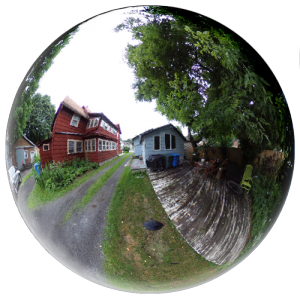
Spherical 360-degree photography is revolutionizing crime scene evidence capture and courtroom presentation. In addition to capturing the crime scene with minimal disturbance and catering to today’s demands for hi-tech courtrooms, as discussed in “It’s all about Perspective Part One: Courtroom Perspective,” 360-degree spherical images have several outstanding applications.
- A Virtual Reality Tool
Spherical photography puts the viewer right in the middle of a scene. In the case of homicides, a 360-degree view of the undisturbed scene can essentially give the deceased a voice in the courtroom by conveying the crime scene surroundings and specific points-of-view that may have been difficult (or even impossible) to convey in another manner. Along the same vein, witnesses can convey their observations more articulately by virtually walking others through the scene as they saw it, at the time of the crime.
- A Time Capsule
Some cases take months or years to go to trial. As time elapses, memories fade. Spherical Images can preserve and trigger the memories of victims, witnesses, investigators and other crime scene personnel. Such recall is useful during trial preparation, as well as during the trial itself, as prosecution develops a visual timeline to walk the judge and jury through the chain of events leading up to and following the crime.
- An Insurance Policy
Crime scene personnel are tasked with capturing every single detail, every single time they investigate a scene. During his eight years as a forensic supervisor, retired Sgt. Hank Kula observed two detrimental actions of investigators at a crime scene. First, when photographing under pressure, they turn their camera on “auto-mode”, which eliminates their control over image quality. Second, they don’t take the time to set up a tripod to capture detail work. Yet crime scene photographs are only as good as the photographer.
John Dobies, retired investigator, asserts, “Spherical photography makes sure ALL evidence is documented. The photographer has to go on past experience and training. They might look at something and think it isn’t relevant. Maybe it IS relevant. With DSLR photography alone, they would have missed it. With the integration of spherical photography, you can be confident you captured everything – even things that didn’t immediately appear relevant to the case.”
- A Resource Preserver
There is a constant challenge to save time and money in government agencies – law enforcement included. Resources, including time, personnel, and equipment, are a commodity to be used sparingly. Work faster, work smarter.
Yet at a crime scene, investigators must take the time required to do their jobs accurately, or their work will be in vain. With DSLR photography, this may mean long hours of properly collecting evidence, but always being subject to questions about what they may have missed. While spherical photography is not meant to replace the precise detail-capture of DSLR photography, it does capture entire scenes, providing context and perspective – and leaving very little room for question. It’s easy, effective, and time-saving.
Further, 360-degree photography software allows spherical images to become the container for all other images, including DSLR photos, and other digital evidence.
- A Persuader
No matter how you look at it, 360-degree photography is convincing. Prior to trial, defense attorneys can virtually experience the crime scene as they determine their defense strategy. Persuasive images may result in a guilty plea, saving time and money from a potentially lengthy and costly trial.
Spherical images are a powerful tool at crime scenes, but the merits of a spherical photography solution expand far beyond the crime scene, to motor vehicle collisions, arson investigations, active shooter pre-planning, and more. Click here to learn more about how OSCR360 was built from the voice of Law Enforcement.